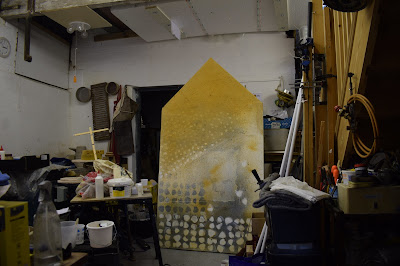Outpost 300823
Mediums To Correspond With.
The Situatedness of Sinuous Form/Animacy Dancing.
Living/Learning with intensity/shelters and camps, AA Field Projects.
Garden Constellation.
Raveningham Transductive Mapping/Diagram.
Cyanotype Spatial Drawing.
Transducers convert the 'ductus' the kinetic quality of the gesture and its flow or movement from one register of bodily kineasthesia to another of material flow.
Brockwood Teaching Academy. 2011.
Speculative Learning Environments.
Brockwood Park Grounds.
A walk in the landscape whilst moving-making with clay.
Developing a mindfulness that is immanent in the attentiveness to ones surroundings through the playfulness of material and others.
Brockwood Park Library.
Hidden Curriculum.
Assemblage in the library for the re-imagining of architectural thinking and spaces for learning.
Architecture without architects.
Throwing Sticks.
The energies of the work,come from the gathering of materials and the gesture that animates them. For Goldsworthy the strength of the work lies precisely in the energies emanating from materials in their movement, growth and decay, and in the fleeting moments when they come together as one. Throwing as Goldsworthy shows us is not so much the outward effect of an embodied agency as the propulsion of animate being as it pulls, spills out into the world, it is the propulsion of life itself.
Ingold/Goldsworthy
Relationscapes/Erin Manning
Making.
The Propulsion Of Animate Being.
Tim Ingold.
The Clay-The Potter-The Wheel.
The potter's feeling flows in and out in a correspondence with the clay.
You do not need clay to 'interact' with the wheel, but you do need a wheel to 'correspond' with the clay. In pottery the mindful or attentive bodily movement of the practitioner, on the one hand and the flows and resistances of the material on the other, respond/correspond to one another in counterpoint of affective resonances, sentient awareness, and the flows/currents of animate life.
The distinction between interaction and correspondence if that, interaction is the dance of agency between definable points and objects, whilst correspondence can be seen as the dance of animacy weaving between all things and their phenomenal flux in the world.
In the dance of animacy bodily kinaesthesia interweaves contrapuntally with the flux of materials within an encompassing morphogenetic field of forces.
The flow of air, the wind, the breath of life are all the very antithesis of embodied agency.
For Ingold the very idea of agency and agents is the corollary of a logic for a closed system of embodiment, a system of closing things up in themselves.
Making/Intuition In Action.
Beyond mere human embodiment and objects and into a world full of correspondences/animacies that propel things and phenomena into the world.
World Without Objects, Tim Ingold.
The choreographic diagram/proposition generates less the stability of a complex of form, than the foregrounding of a field of resonance that defines a certain quality of activity. It speaks/seeks to create a drawing/diagram that captures in a fleeting moment the very qualities of movements and their expressibility such that their force of form can be felt.
Erin Manning.
Drawing, seeing made visible, through the pencil as transducer, not a vector of projection or a bridge between the architects imagining mind and the image on the paper.
The mark on paper leads as much as it is led.
Tim Ingold advocates a way of thinking through making in which sentient practitioners and active materials continually answer to, or correspond with one another in the generation of form.
Individuation's Dance, pushing your consciousness deep into every atom and cell.
Atom and Cell, Nine Horses, David Sylvian.
Correspondences.
The Material of Life.
Drawing into the animacy of things and feelings.
The drawing that tells is a correspondence of kinaesthetic awareness and the line of flight, it is a correspondence that is alternatively sewing the line into the mind and the mind into the line in a suturing action that grows tighter as the drawing proceeds.
The Stage of Drawing, A Walk for Walks Sake, Bryson.
Instead of dictating a thought, the thinking process turns into an act of waiting-listening-collaborating-dialogue in which one gradually learns the skill of co-operating with one's own work. This thinking, this imagining goes on as much in the hands and fingers as in the head, it is strung out in the lines of practice.
Pallasmaa/Ingold.
Thinking Through Drawing.
Barry Phipps.
Drawing is a gathering and a co-operating with one,s own work, a pulling together closer of the lines of inquiry.
Drawing The Line.
Making/Transduction and Perdurance.
Tim Ingold suggests colour saturates consciousness, line leads it. Thus if the line traces a process of thought then colour is its temperament. Both line and colour are modalities of feeling, but where line is haptic, colour is atmospheric.
All Buildings are Drawings.
Simon Unwin.
Only in the eyes of the architect is the trowel a bridge between the initial design and the final construction. For the builder it allows him to navigate the treacherous waters that flow beneath.
Tim Ingold.
When one is young and narrow minded, one wants the text and the drawing to concretise a preconceived idea, to give the idea an instant and precise shape.
Juhani Pallasmaa.

.jpg)
.jpg)












.jpg)


































